Thomas Reichstein | |
|---|---|
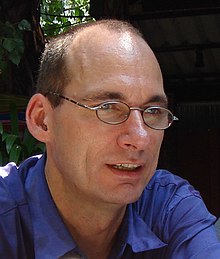 Thomas Reichstein in Bangkok | |
| Born | 24 November 1960 (age 62) Halle/Saale, Germany |
| Occupation(s) | A German sculptor and artist |
Thomas Reichstein (born 24 November 1960) is a German sculptor.
Thomas Reichstein | |
|---|---|
 Thomas Reichstein in Bangkok | |
| Born | 24 November 1960 (age 62) Halle/Saale, Germany |
| Occupation(s) | A German sculptor and artist |
Thomas Reichstein (born 24 November 1960) is a German sculptor.
Thomas Reichstein was born in Halle/Saale. Starting as a gardener, he studied landscape architecture at the university in Dresden TU in Dresden from 1982 to 1984. After this he studied fine arts in the sculptor section of the art school in Dresden Hochschule für Bildende Künste Dresden. [1] His teacher was professor Klaus Schwabe. He got his diploma in 1990.
He became a freelance sculptor in Dresden. From 1992 until 1997 he went to Ghana for three months every year to a brass casting village near Kumasi. Applying the lost wax technique, he produced small abstract and ornamental figures. These objects made him well known in Saxony.
In 1995 he started a workshop with the woodcarvers in Neuireland, an island of Papua. He learned to carve mangrove wood in the Malanggan style. One year later he went to Oro province in Papua. He made tapa cloth from the bark of a tropical mulberry tree. With this material and rattan sticks from Vietnam he created his Rattan-Tapa sculptures. He showed them for the first time in the ethnographic museum in Dresden.
As a result, Thomas Reichstein developed a special type of rattan bark cloth – sculptures. In 1997 he won a competition for the Semperoper Dresden for a yearly given award-sculpture. His idea impressed the jury with the balance of abstraction and reality. Thus he found the successful relation to music, singing and dancing the basic elements of the opera in an equal manner. Since then Reichstein received further orders for price-sculptures from politics and economy (e.g. Dresdner marketing price, MTM Award). From 1 January 1998 to 31 December 1998 taught Thomas Reichstein in the Saxon stonemason school in Demitz – Thumitz. He developed the stonework there specific technical basics of design and taught inter alia freehand drawing, sketching and modeling to nature. Since 1999, Thomas Reichstein operates several months a year in a Buddhafoundry in Ban Pong in Thailand. From 1999 to 2005 he created here a rich series of abstract sculptures. Since 2006 he worked there with the German artist Doreen Wolff and since 2010 even with Catrin Große.

Since 2006 he started to develop a big quantity of human figures.

Since 2006, Thomas Reichstein used again reinforces the human figure to. So he created, for example, in 2009 a group of Nereids – the nymphs from the Mediterranean sea, inspired by classical Greek models from the British Museum in London. Figure table image
Thomas Reichstein was 2000–2012 Chairman of the Saxon artists association and 1997–2012 board member of the Federal Dresden artists. 2005 he was Member of the Board of the Association of Visual Artists (BBK) of Germany. Since 2012, Thomas Reichstein is the CEO of the New Saxon Art Association. Thomas Reichstein is father of four children.
In 2006, Thomas Reichstein wins with a digression into the world of geometry. He designed from Platonic, Archimedean and Catalan bodies a Polyeder-Circlesculpture and thus achieves a competition of Saxony for a study academy first place.
The first prize of a competition of Jena gets Reichstein in 2007 for his sculpture "Big Fish" and " Saalewave". These are very directly involved in the redesign of the promenade along the river Saale in Jena. They are especially designed with a safety ground on touching. The overall project receives in 2009 the Thuringian landscape architecture award.
Since 2010, Thomas Reichstein begins a new convolute from life-sized bronze figures, which has grown by 2013 to 25 works. These develop from creations in statuesque appeal to Lucas Cranach the Elder, to freely moving, dance and expressive representations.
Since first May operates Thomas Reichstein with the painter and sculptor Doreen Wolff, a co-operative gallery in the city center of Dresden, 20 Schlossstrasse, Castle Street in which they show only their own works of art.
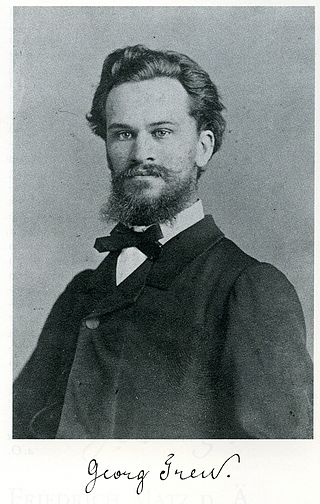
Georg Treu was a Classical archaeologist and curator of the sculpture collection at the Albertinum.
Beate Gütschow is a contemporary German artist. She lives and works in Cologne and Berlin.
Franz Rosei is an Austrian sculptor and draughtsman. His brother is the writer Peter Rosei.
Catrin G. Grosse, also known as Catrin Große, is a German painter, graphic designer and sculptor.
Max Uhlig is a German painter. He won the Hans Theo Richter-Preis of the Sächsische Akademie der Künste in 1998.

Anatol Herzfeld was a German sculptor and mixed-media artist, and also a policeman. A student of Joseph Beuys, he primarily used wood, iron and stone as materials. As an artist, he simply signed Anatol. He received attention for a happening, crossing the Rhine in a boat he created with Beuys, after Beuys had been expelled from the Kunstakademie Düsseldorf.
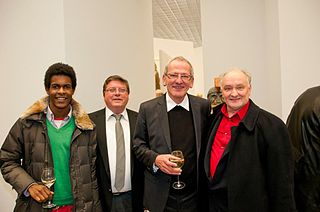
Bernd Schwarzer is a German artist born in Weimar, Thuringia, Germany. Schwarzer's work deals with the subject of Europe, the reunification of East and West Germany, and human rights.

Karlheinz Bux is a German artist concentrating on drawing and sculpture works.
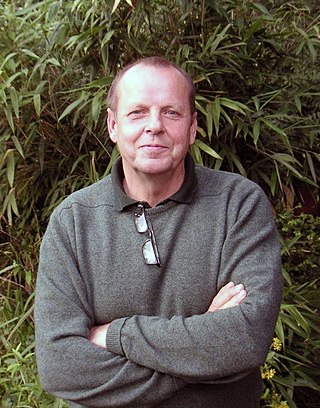
Peter Schwickerath is a German sculptor.
Norbert Prangenberg was an abstract painter, sculptor, and engraver who was born in Nettseheim, just outside of Cologne, Germany. Though he had no formal training and did not fully engage with art until his 30s, Prangenberg did finally come up with a style that was uniquely his own, not fitting comfortably into the neo-expressionist or neo-geo movements of his time, in the 1970s and 1980s. At this time, he was considered a major figure in contemporary German art. Though he got his start with abstract paintings, he also became known for making sculptures of all sizes; and while his work initially appears abstract, the titles given sometimes allude to the human body or a landscape. As a trained gold- and silversmith, as well as a glassblower, he always showed an attention to materials and how they could be physically engaged with. He was interested in how his own two hands could affect the painting or sculpture's surface. Traces of the artist's hand appear literally throughout his entire oeuvre, before he lost the battle with liver cancer in 2012.
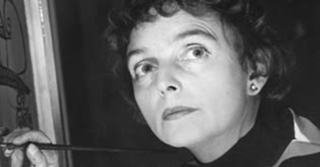
Bele Bachem was a German graphic artist, book illustrator, stage designer and writer. In 1997, Bachem was awarded the Order of Merit of the Federal Republic of Germany.

Joachim Schmettau is a German sculptor.

Laura Bruce is an American contemporary artist living in Berlin.
Wolfgang Kermer is a German art historian, artist, art educator, author, editor, curator of exhibitions, art collector and professor. From 1971 to 1984 he was repeatedly elected Rector of the State Academy of Fine Arts Stuttgart and thus the first scientific and at the same time youngest teacher in this position in the history of the university. Under his rectorate, the State Academy of Fine Arts Stuttgart was reformed in 1975 and 1978 on the base of two new university laws of the State of Baden-Württemberg and thus, for the first time in its history, authorized to set up diplomas for all courses. One of the accents of his work was the promotion of talented graduates of the academy: In 1978 he organized the first of the so-called ″debutant exhibitions″, an ″unconventional contribution to the promotion of young people″, supported financially by the State of Baden-Württemberg.
Stefan Moses was a German photographer living in Munich.

Helmut Heinze is a German sculptor. From 1979 to 1997 Heinze was professor for plastic arts at the Dresden Academy of Fine Arts.

Ingo Kühl is a German painter, sculptor and architect.
Carl Heumann was a German art collector persecuted by the Nazis because of his Jewish origins.
Magnus Weidemann was a German painter, graphic artist, photographer and writer. He was a co-founder of naturism in the life reform.

Ingrid Hornef is a German sculptor, installation artist, curator and painter. She is a representative of Concrete art and became best known for using a dice as a random number generator in her series of works Alea iacta est.